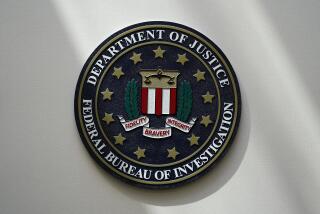Plot posed a real and immediate threat, experts say
It was not the most spectacular domestic terrorism plot since the Sept. 11 attacks, and certainly not the best-known.
But no other case posed such a real and immediate threat as the audacious scheme to attack more than a dozen military centers, synagogues and other sites in Southern California, experts said Thursday.
âIf you look at the roster of defendants in terrorism cases, it often seems like a casting call. They all have aspirations, but most lack real talent and helpful connections,â said Brian Levin, an attorney and director of Cal State San Bernardinoâs Center for the Study of Hate and Extremism.
âBut here you actually had a case where defendants had a radicalized ideology, a list of targets and they had already gone from planning to operations,â Levin said. âThis was beyond merely a threat. In this instance, they were operational.â
The guilty pleas announced Friday in what is known as the JIS case represented an important win for the Justice Department, after a string of high-profile courtroom defeats in terrorism-related prosecutions. Just Thursday, a jury in Miami acquitted one man charged with plotting to blow up the Sears Tower in Chicago and deadlocked on charges against his six alleged accomplices.
The courtroom ending mirrored a mistrial declared earlier this year in a Dallas prosecution against five Islamic men accused in the largest terrorism-financing case brought by the U.S. government.
âThe bottom line is that when you look at a lot of these prosecutions, many people are accused of lying to investigators or [other crimes] rather than terrorist acts or threats to national security,â Levin said. âAnd that is why you have seen a bit of prosecutorial fatigue set in with the public. . . . There is a lot of talk about what could have happened in a caseâ rather than evidence of a pressing threat.
By contrast, the JIS plot was within 60 days of launching, according to sources close to the investigation.
The case illustrated how quickly authorities must be prepared to move in the event of an actual terrorist threat, they said. In a matter of weeks, the FBI, Los Angeles and Torrance police departments and two dozen other agencies conducted 19 searches, seized two dozen computer hard drives and examined about 53,000 documents, all without the normal luxury of moving at their own pace with undercover informants, surveillance and wiretaps.
The plotters âwere flying dangerously below the radar,â said the FBIâs John Miller, who was the LAPDâs counter-terrorism head at the time the case broke. He added that the defendants had robbed gas stations for the money to buy rifles, had picked their targets and had set a date.
âThe clock was ticking. All they needed to do was to start killing,â he said.
The prison-hatched scheme raised another fear in U.S. counter-terrorism circles, particularly within California, which has the nationâs largest inmate population: Were there other members of the conspiracy, spawned in cellblocks and prison libraries, preparing to carry on the plan?
âWe were confident that we could make a case against the people we had in custody,â said Randy Parsons, the retired former head of counter-terrorism for the FBI in Los Angeles. âOur greatest concern was: Did we miss somebody? Is there somebody who has been released from prison or radicalized on the street that we might have missed who might be about to go operational?â
More than 350 federal agents, state investigators and local police worked five weeks, around the clock, to determine if others had escaped their dragnet. In the end, they did not find additional accomplices, but their investigation led to new intelligence coordination between prison officials and outside law enforcement.
For all its urgency, however, the case never drew the attention of lesser threats. One reason was that news of the JIS investigation trickled out over the course of weeks.
In addition, the federal indictment of the four defendants, though announced by top Justice Department officials in Los Angeles and Washington, was unsealed as the nationâs attention was riveted on Hurricane Katrinaâs devastation of New Orleans.
Too, the men charged with terrorism did not fit the stereotype of the foreign-born menace that had been drilled into the American psyche after Sept. 11.
For professor Levin, that may be the long-term lesson of the case.
âI think this case shows you cannot racially or religiously profile an ideology. It is fanaticism, not faith, that drives this extremism,â Levin said. âAnd disenfranchised people will craft their hatred into an ideology of their choice. That is why religious converts are so good for this radicalization . . . because those who have been raised in a faith know better.â
--
More to Read
Sign up for Essential California
The most important California stories and recommendations in your inbox every morning.
You may occasionally receive promotional content from the Los Angeles Times.










